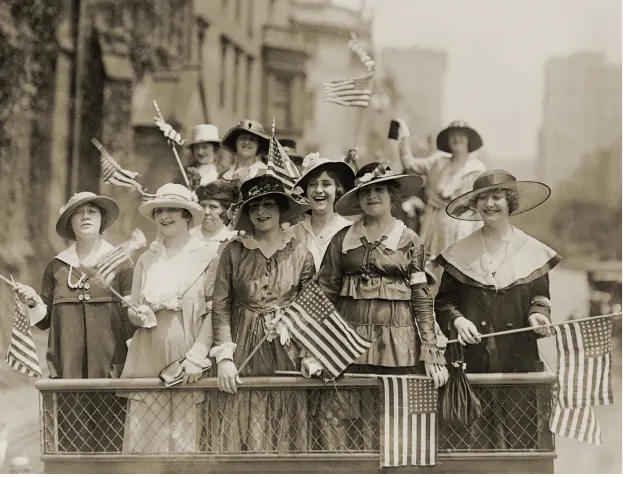
Voices of Change: Women, Citizenship, and the Fight for Equality
Voices of Change: Women, Citizenship, and the Fight for Equality
Honoring the Heroines Who Fought for the Freedom to Be Heard
In the pursuit of liberty, not all battles are waged on distant front lines—some are fought in city halls, church basements, factory floors, and kitchen tables. For generations, women have championed causes that shaped the contours of freedom—not only for themselves, but for their families and communities.
When we trace our family histories, we may uncover quiet heroines whose influence reached far beyond what official records reveal. Their strength often took the form of community organizing, wartime labor, moral courage, and persistent advocacy. In this month’s Roots of Our Freedom series, we celebrate the legacy of women’s rights movements and explore how these threads may run through your own family tree.
From Margins to Movements: A Brief History of Women’s Rights
The story of women’s rights in North America is one of slow but steady advancement. In the 19th century, women began organizing for voting rights, property ownership, and educational access. The suffrage movement gained momentum in both Canada and the United States, culminating in landmark victories:
Canada: Most women won the federal vote in 1918 (though Indigenous women with status had to wait until 1960).
United States: The 19th Amendment, ratified in 1920, granted American women the right to vote.
These milestones were hard-won, built on decades of petitions, protests, and quiet courage. Many women in our family trees may have been involved—as signatories, speechmakers, or simply by showing up when it mattered most.
How to Trace Women’s Roles in Your Family Tree
Finding women in historical records can be challenging due to name changes and social roles, but here are some research strategies:
Look for Church, School, and Volunteer Records
Women often served on auxiliary committees, hosted fundraisers, or taught in community schools.
Newspapers and Local Histories
Obituaries, anniversary notices, and social columns can offer clues about community involvement.
Petitions and Census Records
Some suffrage petitions have been digitized; check both federal and provincial/state archives.
Occupation and Union Records
Women in trades, teaching, and nursing may be recorded through professional associations.
Oral Histories
Interviewing older relatives can reveal stories not found in documents—personal recollections are gold.
Case Study: Clara Weiss – A Voice That Crossed Borders
Born in 1889 in Krakow, Poland, Clara Weiss was no stranger to injustice. As a Jewish woman in a partitioned country, she faced both political and religious restrictions. After immigrating to Montreal in 1911 with her younger sister, Clara worked as a seamstress in the city’s booming garment industry—a space that became both her livelihood and her launchpad for activism.
Clara joined the International Ladies' Garment Workers' Union and quickly became known for her fiery speeches during lunch-hour rallies. In 1917, she helped organize a strike at a downtown Montreal coat factory, demanding better wages and a 9-hour workday. Her commitment earned her both the admiration of her fellow workers and the surveillance of local police.
But Clara's activism didn’t end with labor. In 1918, inspired by suffrage leaders like Nellie McClung and Thérèse Casgrain, she began speaking at women’s rights meetings. She believed that political power was essential to securing dignity in the workplace and safety at home. Clara became a fixture in both Jewish and francophone feminist circles, bridging cultural gaps with her multilingual fluency.
She married a fellow organizer, raised two children, and never missed a local election. Her granddaughter would later become a city councillor in the very neighborhood where Clara once stitched linings and passed out flyers.
Clara's story is fictional—but grounded in the very real histories of thousands of immigrant women whose names were rarely printed, but whose impact was immense. Through her, we remember the many Claras who turned hardship into hope, and whose footsteps may echo in our own families.
Bringing Their Legacy Forward
Documenting the contributions of women in your family takes curiosity and creativity. Here’s how to begin:
Map Women’s Lives Alongside the Men
Add mothers, sisters, and daughters with equal detail—note occupations, schooling, and volunteer work.
Preserve Family Letters and Recipes
Domestic ephemera often carries social and political context—wartime rationing, voting drives, or activism.
Record Stories About Advocacy or Resistance
Whether it was attending a protest or refusing a social norm, these moments matter.
Photograph Heirlooms with Stories Attached
A brooch worn to a suffrage meeting. A book of poetry by a favorite reformer. These bring the past to life.
Honor Multi-Generational Impact
Note who passed down what—skills, beliefs, or encouragement to fight for justice.
Legacy: The Right to Speak, to Vote, to Belong
Freedom isn’t just a flag or a vote—it’s the ability to be heard and to shape the world around you. The women in our family trees often claimed this freedom quietly, persistently, and with great cost.
This month, let’s remember that their courage helped lay the foundation for the liberties we enjoy today. And if you haven’t yet found a woman like Clara in your own family’s story—perhaps that’s because you are her next chapter.
What You Can Do This Month
Share a photo or story about a woman in your family who influenced your worldview
Visit your local archives or library to explore women’s suffrage in your region
Use the hashtag #RootsofOurFreedom to celebrate women’s voices in history
Record an oral history with a mother, aunt, or grandmother


